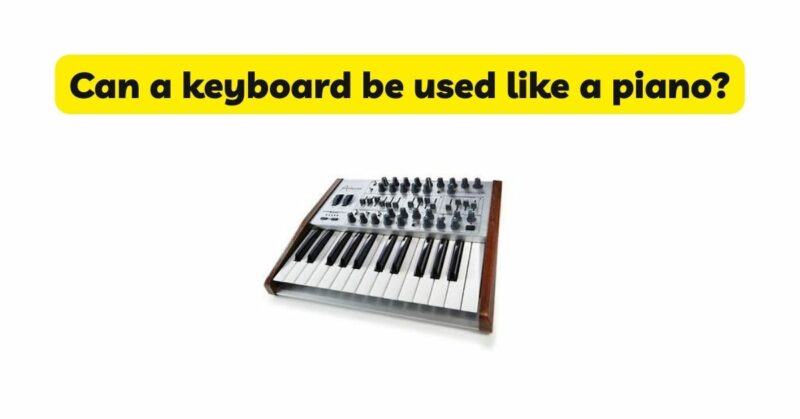Keyboards have become increasingly popular in contemporary music production and performance due to their versatility, portability, and wide range of features. However, many musicians wonder whether a keyboard can effectively replace a traditional piano. In this article, we will explore the capabilities and limitations of using a keyboard as a piano substitute. From weighted keys to sound quality and expressive control, we will delve into the potential of keyboards and discuss how they can be used to emulate the experience of playing a piano.
I. Weighted Keys: Capturing the Piano Feel
One of the key elements that distinguishes a piano from a keyboard is the weighted keys. Traditional pianos have hammers and strings that require more force to produce sound, resulting in a tactile and expressive playing experience. While many keyboards feature non-weighted or semi-weighted keys, there are also models available with fully weighted keys that simulate the feel of playing a piano.
Keyboards with weighted keys utilize various mechanisms, such as hammer action or graded hammer action, to mimic the resistance and response of a piano. These keyboards offer a closer approximation of the piano playing experience, enabling musicians to replicate the touch sensitivity and dynamic range found in traditional pianos.
II. Sound Quality: Reproducing Piano Tones
The quality of sound produced by a keyboard is another critical aspect to consider when using it as a piano substitute. While keyboards may not possess the exact tonal characteristics of an acoustic piano, they often feature high-quality piano samples or digital synthesis technologies to emulate piano sounds.
Modern keyboards incorporate advanced sound engines and digital processing to capture the nuances of acoustic pianos. Sample-based synthesis or physical modeling techniques are employed to create realistic piano tones, aiming to replicate the timbre and resonance of a traditional piano as closely as possible. These advancements in sound production enable keyboards to provide convincing piano sounds that can satisfy the needs of many musicians.
III. Polyphony and Layering: Creating Complex Arrangements
Another advantage of using a keyboard as a piano substitute is its polyphony capabilities and layering options. Polyphony refers to the number of notes that can be played simultaneously, and keyboards often offer a higher polyphony count compared to traditional pianos. This enables musicians to perform complex arrangements with multiple voices and harmonies without encountering note cutoff or voice stealing.
Keyboards also allow for layering sounds, which means combining different instrument tones or effects to create a richer and more textured performance. By layering piano sounds with strings, pads, or other instruments, musicians can add depth and complexity to their playing, expanding the sonic possibilities beyond what a piano can offer.
IV. Expressive Control: Dynamics and Articulation
Expressive control is an essential aspect of piano playing, and it is crucial to evaluate how well a keyboard can capture the dynamics and articulation of a piano performance. While keyboards may not possess the same level of touch sensitivity as pianos, they often incorporate features that allow for expressive control.
Velocity sensitivity is a common feature in keyboards, which means the keys respond to the force with which they are struck. This feature enables musicians to control the volume and intensity of the notes by varying their touch. Some keyboards also provide additional expression controls, such as modulation wheels, pitch bend, and aftertouch, which can further enhance the expressive capabilities of the instrument.
V. Portability and Versatility: Taking the Piano Anywhere
One of the significant advantages of using a keyboard as a piano substitute is its portability and versatility. Keyboards are lightweight, compact, and easy to transport, making them suitable for rehearsals, gigs, or performances in various settings. Traditional pianos, on the other hand, are heavy and require specific setups, limiting their mobility and flexibility.
Keyboards also offer a wide range of features beyond piano sounds, including other instrument emulations, synthesizer capabilities, built-in effects, and recording options. This versatility allows musicians to explore different genres, experiment with sound design, and expand their musical horizons beyond the scope of a traditional piano.
VI. Pedal Control and Accessories: Enhancing Piano Techniques
Pedal control is an important aspect of piano playing, as it enables musicians to sustain, soften, or alter the sound of the instrument. While some keyboards may include built-in pedal inputs, using external MIDI-compatible pedal controllers or utilizing keyboard-specific pedal attachments can provide a more immersive piano-playing experience.
Additionally, accessories such as keyboard stands, adjustable benches, and ergonomic setups can help create a more piano-like environment and facilitate comfortable and natural playing postures.
Conclusion:
While a keyboard may not perfectly replicate the experience of playing a traditional piano, it can serve as a viable substitute with its own unique advantages. With weighted keys, high-quality sound production, expressive control, and versatile features, keyboards offer a range of capabilities that can closely approximate the piano-playing experience.
Using a keyboard as a piano substitute allows for portability, versatility, and the ability to explore various musical styles and genres beyond the traditional piano repertoire. It provides musicians with the freedom to create, perform, and record their compositions without the limitations of size, weight, or logistical constraints associated with traditional pianos.
Ultimately, the decision to use a keyboard as a piano substitute depends on personal preferences, musical goals, and the specific requirements of each musician. Whether for practicing, performing, or music production, a keyboard can unlock new possibilities and inspire creativity while offering a satisfying and expressive piano-like experience.


